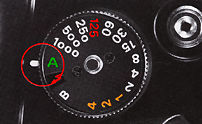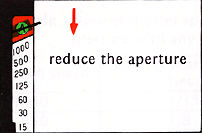TTL
EXPOSURE METER
| Center-weighted
Exposure Meter The exposure meter adopts the TTL center-weighted light metering system. The meter reads light over the entire focusing screen, but its light sensitivity is concentrated in the center, which corresponds to the central 1 2mm diameter spot of the screen. For best results, always place the main subject in this central area when metering. The meter takes advantage of the automatic diaphragm feature of the Nikkor lenses (auto) to measure light at the maximum aperture of the lens. This insures the brightest possible image on the focusing screen for viewing and focusing and minimizes the influence of light entering through the finder eyepiece. |
|
To turn on exposure meter When the film is manually advanced, the exposure meter is turned on by pulling the film-advance lever out to uncover the red dot (an angle of about 30°). In this case, the shutter button lock is to be placed in its locked position.
 |
When using the Auto Winder AW-1, the exposure meter is turned on by turning the shutter button lock so as to uncover the red dot. In this case, the film-advance iever is to be placed in its locked position, flush against the camera body.In automatic exposure control, it is sufficient to simply release the shutter after setting the lens aperture and focusing the subject. However, it is recommended that the position of the exposure meter needle (shutter speed value in the finder) be confirmed without fail before taking pictures. |
Other
than if you wish to create intentional blur like panning the camera at slower speeds,
photographs may be blurred if the camera is held by hand at speeds of 1/30 sec. or
slower, adjust the lens aperture to obtain a shutter speed faster than 1/60 sec.
When you wish to use slower shutter speeds stabilize the camera by means of a tripod
or something solid. Caution: To prevent battery
drain, keep both the film advance lever and the shutter button lock in thelocked
position to switch off the meter whenever the camera is not in use.
Confirm the shutter speed indicator Under the automatic exposure control,
confirm the black needle (indicating the shutter speed) in the viewfinder if it is
indicating the proper shutter speed. With shutter speeds slower than 1/30 sec., secure
the camera with a tripod to avoid blurred pictures. Also note that if the black needle
indicates A or B (the warning zones) - i.e. the subject is too bright or too dark,
change the aperture to keep away the black needle from A or B. (Position at "A"
for AUTO while "B" stands for "Bulb" or for Time expsoure").
|
When
the black needle is out of the range |
||
|
Subject is too Bright |
Subject is too Dark |
|
|
|
|
|
|
If the black needle does not come in the range even with the minimum (smallest) aperture, use ND filters, etc. to reduce the luminosity. |
If the black needle does not come in the range even with the maximum (full) aperture, use flash lights, etc. to increase the luminosity. |
|
Extreme-high or low light situations If the black needle remains in "A" or "B" after all possible aperture settings have been tried, then the available light is too bright or too dim to cover the meter's EV range. Switch to a new film that matches the available light or mount a neutral density (ND) filter onto the lens to cut down on the amount of light or use artificial light to increase luminosity, whichever is appropriate.
Operable shutter speed
 |
 |
The camera's meter may be used only within the shutter speed range covered by the exposure value (EV) range of the meter, which varies with the aperture and ASA setting.
The EV chart (See below section) shows the relationships between the f-stop, shutter speed and film speed, indicating the slowest functioning shutter speed (for metering purposes) with any film speed/f-stop combination. Careful attention to the following instructions will assure precise exposure, automatically, over the complete exposure control and meter range capability of your Nikkormat ELW.
Auto exposure control at full aperture For example, with an f/1.4 lens and ASA 100 film, the ELW's automatic shutter will function down to one second with the lens set at 1.4, and proportionately slower as the aperture is closed.
Using a standard of ASA 25 film, you may be assured of at least a four second speed regardless of the aperture of the lens used as long as the lens is set at full aperture. Using ASA 400 at f/1.4, the slowest speed is 1/4 second; however, as the aperture is closed, the functioning shutter speed becomes progressively slower until we reach f/5.6 when the slowest speed of four seconds is functioning.
Auto exposure control with stop-down metering When using a bellows or other extension equipment, which disengages the meter coupling device, it is necessary to revert to stop-down metering. Certain limitations are imposed in this mode. As lens-to-film distance is increased, the metering range (EV range) changes proportionately. For example, when an f/2 lens is used at 2:1 reproduction (twice life-size) the effective f/number is f/5.6. When used at f/8, the effective f/number is f/22. When pictures are taken under minimal light levels, it is desirable to use a high-speed film (ASA 160 or higher). Using Tri-X at film speed 400 with stop-down metering, with an effective f/number of f/8, the shutter speed range would be from 1/4 second to 1/1000. Should the light level drop below EV6, it would be out of the shutter speed range of the meter.
Table :
|
Slowest shutter speed at full aperture with any lens |
|
|
ASA Film speed |
Slowest shutter speed (sec.) |
|
1600 |
1/15 |
|
800 |
1/8 |
|
400 |
1/4 |
|
200(160) |
1/2 |
|
100 ( 80) |
1 |
|
50 ( 64) |
2 |
|
25 |
4 |
How to read the EV range chart
The chart indicates the EV (for ASA 100) vs. shutter speed range. To determine the shutter speed range, note that the bars in section A indicate the responsive range of the ELW's photosensitive CdS element (i.e., f/8 covers EV6-22, f/16 covers EV8-22) for the f-stop in use.
In Section B, note the f-stop being used on the appropriate ASA scale. For example, at ASA 25 with the lens set at f/8, we follow the line diagonally and find that it intersects EV6 at four seconds, and at EV18 runs off the scale at 1/1000 second. ASA 100 at f/8 runs from EV4 at four seconds to EV 16 at 1/1000 second.
 PDF file (276k) Click here will open a new window if you have a plug-in for adobe's PDF reader . |
In any case, it is generally the low end which requires a careful check. The wide exposure (EV) range of the Nikkormat ELW will encompass most lighting situations. It is only under dim-light or rare bright-light situations that any special attention need be paid. |
Full-aperture metering The metering range is determined by the bars (Section A), f/number range in appropriate ASA scale (Section B) and shutter speed (4 - 1/1000 sec., Section C). For example, the green area encompassed by the heavy lines demonstrate a combination of a 50mm f/1.4 lens and ASA 100 film.
Stop-down metering The metering range is determined by the bars (Section A), f/number in appropriate ASA scale (Section B) which corresponds to the stoppeddown aperture in operation, and shutter speed (4 - 1/1000 sec., Section C). The green line demonstrates stop-down measurement in the case of an f/8 lens combined with ASA 100 film, indicating a range from 1 sec. to 1/1000 sec.
| Previous | Setting Aperture value, focusing, prefocus, rewind and unloading film with ELW
| Next | Exposure Control with EL-W and Various application (6/8)
Back to Main Index Page of Nikkormat EL-W
| Back | to Main Index Page of Nikkormats EL Series
| Back | to Main Index Page of Nikkormats
History & Background of Nikkormat Cameras
"Nikomat" Picture Library of Japanese local version
Outline the major key features and differences of various models
The Camera Bodies | FT | FS | FTn | EL | FT2 | ELW | FT3 | EL2
| Main Reference
Map
|
HTML Format: FT | FS | FTn | EL | FT2 | ELW | FT3 | EL2 | AW-1 Motor Winder
PDF Format: FT
| FS | FTn | EL | FT2 | ELW | FT3 | EL2 | AW-1 Motor Winder
| Specifications |
FT
| FS | FTn | EL | FT2 | ELW | FT3 | EL2
| Message
Board
| for your favourite Nikkormats
| Message Board |
for your Nikon Optics in a shared environment
| Message Board |
Specifically for Dispose or Looking for Nikon/Nikkor Photographic
Equipment
 |
The Eyes of Nikon:- |
Fisheye-Nikkor Lenses - Circular | Full Frame | Ultrawides Lenses - 13mm15mm18mm20mm | Wideangle Lenses - 24mm28mm35mm |
Standard Lenses - 45mm 50mm 58mm | Telephoto Lenses - 85mm105mm135mm180mm & 200mm |
Super-Telephoto Lenses - 300mm 400mm 500mm 600mm 800mm 1200mm |
Special Application lenses:
Micro-Nikkor Lenses - 50mm~55mm -60mm 85mm -105mm 200mm Micro-Zoom 70-180mm
Perspective Control (PC) - 28mm 35mm PC-Micro 85mm
Dedicated Lenses for Nikon F3AF: AF 80mm f/2.8 | AF 200mm f/3.5 EDIF
Depth of Field Control (DC): 105mm 135mm
Medical Nikkor: 120mm 200mm
Reflex-Nikkor Lenses - 500mm 1000mm 2000mm
Others: Noct Nikkor | OP-Nikkor | UV Nikkor 55mm 105mm | Focusing Units | Bellows-Nikkor 105mm 135mm
Nikon Series E Lenses: 28mm35mm50mm100mm135mm | E-Series Zoom lenses: 36~72mm75~150mm70~210mm
MF Zoom-Nikkor Lenses: 25~50mm | 28~45mm | 28~50mm | 28~85mm | 35~70mm | 36~72mm E | 35~85mm | 35~105mm | 35~135mm |
35~200mm | 43~86mm | 50~135mm | 50~300mm | 70~210mm E | 75~150mm E | 80~200mm | 85~250mm |
100~300mm | 180~600mm | 200~400mm | 200~600mm | 360~1200mm | 1200~1700mm
Tele-Converters: TC-1 | TC-2 | TC-200 | TC-201 | TC-300 | TC-301 | TC-14 | TC-14A | TC-14B | TC-14C | TC-14E | TC-16 | TC-16A | TC-20E
![]()
Nikon F
| Nikon F2 |
Nikon
F3
| Nikon F4 |
Nikon
F5
| Nikon F6 |
Nikkormat / Nikomat |
Nikon FM
| Nikon FE/ FA | Nikon EM/FG/FG20 | Nikon Digital SLRs | Nikon - Other models
MIR Supports for Photographic Community: Various Message Boards/Community
Forums
Nikon
F-series|
Nikon
F2-series|
Nikon
F3-series|
Nikon F4-series| Nikon
F5-series|Nikkormat/Nikomat-series
Nikon FM-series|Nikon
FE-series|Nikon
FA|Nikon
Digital
SLR
series|Various
Nikon
Models|Nikkor
Optic
-shared
Others:- Free Trade Zone - Photography| Free Trade Zone - Business Community |Free To Zouk - Photographic Community
Apple's Mac Public Community Message Board | Windows based PC &
Apple/Mac
Public Community Trade Exchange Centre
Recommended links to understand
more technical details related to the Nikkor F-mount and production Serial Number:
http://rick_oleson.tripod.com/index-153.html by: my friend, Rick Oleson
http://www.zi.ku.dk/personal/lhhansen/photo/fmount.htm by: Hansen, Lars Holst
http://www.mir.com.my/rb/photography/hardwares/nikonfmount/lens2.htm
http://www.photosynthesis.co.nz/nikon/serialno.html
About
this photographic
site.
Home - Photography
In Malaysia
![]()
Copyright
© 1998.
HIURA Shinsaku ® ; Nikomat ML, Japan,
in collaboration with leofoo ®. MIR Web Development Team.
* Credit: A
Great thanks to Mr Denis Pleic for his volunteering
effort to reedit content and and patching some grammatical mistakes found in this
section of the PIM site. Miss
Rissa (Marketing) & Edward
(Techical) of Shriro Malaysia, distributor of Nikon cameras in Malaysia, in providing
so many useful inputs to make this site possible. Mr Hong,
Ipoh for lending me his FT2 to take some of the images used in this site. This site
is created for his eldest son, Yuen who has picked up his father's hobby and
the FT-2. My friend, John Walls from Florida, US for his images of the FTn
body and the Zoom Nikkor
43-86mm.
[Left Brain][Right brain][Home-MIR] [Invention][Art & Design][Clubs]
[Portfolios][On assignments] [Trading room][Knowledge & Resources] [Free-trade-zone][Thoughts & opinions][Links]


